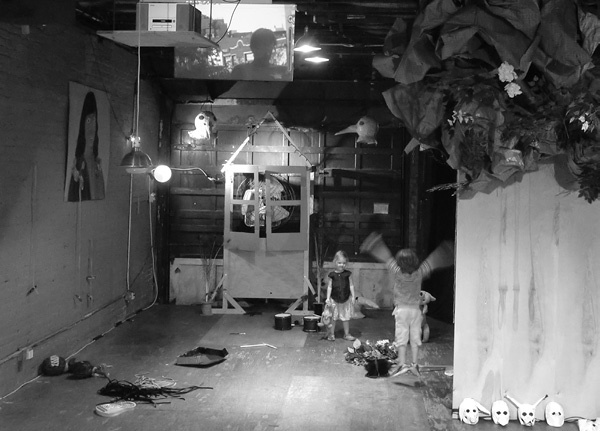
THE BACCHAE
first performed on
September 7, 2011
Collapsable Hole, Brooklyn, NY
performed seven times in 2011
SCIENCE PROJECT / YELENA GLUZMAN
with Sabine Gutenberg, Gen Gluzman, George Truman, Petra Dijur, Anska Hilash, and Avner and Penny Shahar (performers); Alaina Mahoney (angry grape puppets), MP Fusco (masks, lion skin, and severed head); Ilya Bernstein (lyrics/story) and Jed Shahar (music)
THE BACCHAE
SCIENCE PROJECT / YELENA GLUZMAN
Why do we do things over and over again in a rehearsal? The repeated action is always compared to an imagined action that doesn’t yet exist. Repetition in a rehearsal is a molding process, where actions are molded ever more minutely to fit a projected ideal, even when the ideal itself changes over time.
This approach is problematic because it is retrogressive: since all repetitions are subservient (indeed, are led by) their proximity to a pre-existing ideal, the action created in performance gestures toward an idea-belief held previously. Of course, since it is very rarely the case that performed actions (no matter how well they were rehearsed) match an ideal action perfectly, the ideal is rarely seen and almost impossible to directly acknowledge, question, or critique. Other than resorting to improvisation, is there any other way to make a performance? Or rather: is there any other paradigm of repetition that could change our understanding of how repetition functions in creating performance?
“The Bacchae” was an experimental workshop in which the performers were children ages three to six. Throughout seven rehearsal-performances, the children were never given tasks, but allowed to freely respond to a repeated theatrical environment and to each other. The environment included objects (costumes, masks, a burlap lion skin, cardboard swords, a thyrsus, and plastic foliage, etc.), video projection, a small invited audience of adults, and a 50-minute soundtrack. Theatrical elements were put into the control of the children; for example, lights changed in response to their specific actions. The soundtrack, written by Ilya Bernstein and arranged by Jed Shahar, re-told Euripides’ Bacchae in poems, songs, and simple dialogs. The parents of the children were asked not to join the audience, but instead to watch the performances from outside the theater, through a live video feed. They, while watching their children perform, were also filmed and projected in real-time into the performance space. The forced separation between the parents and children both activated the terror of the Bacchae story and created a second, virtual audience for the performing children. In “The Bacchae” I looked at the use of repetition in performance by children not as a developmental phenomenon, but as an alternate model of how repetition may be used, focusing on how and when their repetition incorporated variation, and the effects of repeated acts, both on performers and spectators. Children functioned as creators and were not regarded as incomplete/moving towards completion.
This constituted the first phase of “The Bacchae.” The next phase, in 2012, will involve a year-long process with an expanded performance environment, including video and sound elements the children can control.